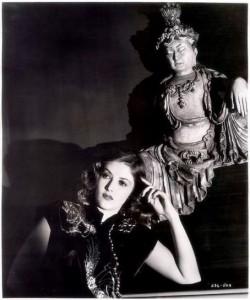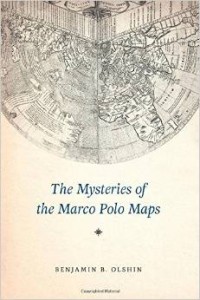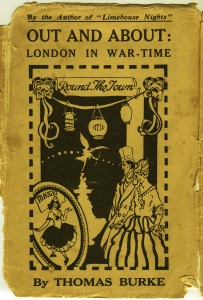Posted: February 21st, 2015 | No Comments »
I blogged a while back about the freuency with which hard boiled novelist Raymond Chandler mentions Chines rugs in his Philip Marlowe books. Happened to be watching the Bogart-Bacall movie of The Big Sleep the other night and realised I’d forgotten about the Chinoiserie house rented by the antiquarian bookseller/pornographer Geiger for his pornography shoots. In the book the girl Carmen Sternwood is naked, though in the movie she’s draped in Chinese style silks – but the implication is clear that she’s been snapped for porno cards and a bit of possible blackmail. Carmen has been doped by Geiger. Had forgotten that…..



Posted: February 20th, 2015 | No Comments »
Reading Mark O’Neill’s recent book on the Chinese who worked on the Eastern Front in WW1. I wondered what happened to those men – many came home, others stayed in Russia and their fates are lesser known. Many presumably ended up in various Chinatowns in Russia such as those at Vladivostok (there are some incredible pictures of Millionka here by the way that I didn’t know about) and Murmansk I’ve written about recently. Others? who knows – one small anecdote from Truman Capote when he visited Russia in 1956 is perhaps instructive – a young man in 1914 of say, 20, would be in his early sixties in 1956 and similar to Capote’s Chinese encountered on Brest-Litovsk Railway Station. Brest-Litovsk is now simply Brest in Belarus.
Capote recounts his encounter in The Muses are Heard as he wanders through the few kiosks set up to supply victuals to the train passengers heading to St Petersburg (Leningrad)…
It was puzzling to discover that each of the kiosks sold the same products, cans of Red Star salmon, Red Star sardines, Kremlin perfume, dusty bottles of Kremlin candy, pickled tomatoes, hairy slabs of raw bacon slapped between thick slices of grime coloured bread, weird liqueurs, cross buns (without the cross) that one somehow felt had been baked last July. And though the kiosks were attracting a brisk trade, the most sought after item was not on sale at any of them. It was in the private hands of a peddler, an elderly Chinese who carried a tray of apples. The apples were as shriveled and miniature as himself, but his waiting line of customers appeared disconsolate when the last of them evaporated. At the far end of the area a flight of steps led to the main entrance of the station, and the Chinese, folding his empty tray, wandered over to them and sat down next to a friend. The friend was a beggar bundled in an old army coat and with a pair of crutches sprawled beside him like the wings of a wounded bird. Every third or fourth person going by dropped a coin into his hand. The Chinese gave him something too. An apple. He’d saved one ofr the beggar, and one for himself. The two friends gnawed their apples and leaned against each other in the cutting cold.Â

Brest Litovsk train station around the time of the First World War


Capote
Posted: February 19th, 2015 | No Comments »
Occasionally I come across a story that convinces me that everything I think and write about old Shanghai is absolutely true!! Meet CC Julian….
In the late 1920s, the Julian Petroleum Corporation defrauded some 40,000 investors of US$150 million in one of America’s earliest Ponzi schemes. The Julian scam was centred on Southern California and the oil boom of the early 1920s. Courtney Chauncey (C.C.) Julian, a native Canadian, arrive din California in 1922 claiming experience in property speculation and the oil business. Julian secured a lease to drill on five acres at Santa Fe Springs and advertised for investors in the Los Angeles Times and other newspapers. In June 1923, he launched the Julian Petroleum Corp., a venture that he claimed would supplant Standard Oil. In 56 days, he sold US$5 million worth of stock in “Julian Pete.” He lived large in LA, went to the best nightclubs, with the most beautiful women and got in a fight with Charlie Chaplin over something or other.

Julian Petroleum looked fishy and the California corporations commissioner launched several investigations into his activities. It was bad news for many ordinary folk and celebrities who had invested with Julian. In May 1927, the Los Angeles Stock Exchange halted trading in Julian Petroleum. The company had been authorized to issue 159,000 shares of preferred stock. Almost 4 million shares had entered circulation. The fraud exceeded US$150 million. Tens of thousands of stockholders lost their investments. As the legal suits mounted and court dates became legion what did Julian do? Why, of course, what any scoundrel and fraudster in the early 1930s would do – he got caught up in another scam in Oklahoma and then jumped ship to Shanghai…

Shanghai’s lax entry regulations were ideal. Julian got a false passport and posed as an Irishman called TR King, dressed shabbily and appeared to be down-on-his-luck. He managed to board a ship in Seattle and got off in Shanghai on March 23rd, 1933. Julian shed his shabby clothes, his fake Irish accent and checked into a suite at the Astor Hotel (today’s Pujiang Hotel). American justice went after him in Shanghai but Julian was a Canadian and the laws of extraterritoriality made it virtually impossible to get him in a court room. Recognized by an American also staying at The Astor, Julian told the press, ‘You can tell the United States to go to Hell!’, ‘They can’t touch me.’ With a stash from his US swindles The Astor wasn’t swanky enough for Julian and he moved into The Metropole (see my posts on that hotel here), close to the American Court for China at Shanghai, the American Consulate, American Club and the HQ of the Shanghai Municipal Police and Special Branch. Reports had him in the bar at The Metropole (about to be trashed – see my post here) with ‘cabaret girls and liquids that bubble.’

The Astor Hotel
But Shanghai didn’t work for him. For a year he tried to peddle every scheme he could think of and sank slowly into drunkenness and alcoholism. But Shanghai was a city of con-men and he simply got conned himself most of the time. On September 10th 1933 he bought a friend a drink and declared, ‘That’s my last dollar.’ The Metropole kicked him out. He moved to a nondescript (and sadly not named) Frenchtown hotel. He tried a few more tricks – borrowed a lot of money from Chinese businessmen who weren’t quite aware of his past, and never paid it back. He claimed to have written an autobiography which his lawyer said was good and kept on appealing to the ladies. After a fruitless year Julian took the last of his borrowed money and checked back into the Astor Hotel. After a lavish dinner he went back to his Shanghai hotel room at 1am one evening, left his girlfriend, a stenographer he had been running around town with, and a lot of empty champagne glasses behind, and swallowed poison. He died five hours later…penniless and on the lam from US justice. His death was recorded as a suicide. His girlfriend, a certain Leonora Levy (who sadly I know nothing much about except her father, a cinema manager in Shanghai was murdered in 1924!) took what was left of his poison and slipped into a coma. She survived and stayed loyal though there was another woman, a Russian called Madam Cantarovich who claimed to have been his lover previously, and had the diamonds he’s showered her with to prove it, so she claimed.
 The Astor’s dining room
The Astor’s dining room
Julian was broke but a Shanghailander Canadian, who remained anonymous, paid for C.C.’s funeral and, Dr. Emery W Luccock of Oak Park, Ill, pastor of the American Community Church of Shanghai agreed to preside. Nine people attended his funeral, held in the Shanghai Municipal Mortuary, including his Frenchtown landlady who’d kicked him out for non-payment of rent a few days before, two newspapermen in the hope of a stringer’s fee and two ‘young twittering girls’. He got a beggar’s coffin and an unmarked grave in the foreigner’s cemetery. As the earth was thrown in on the coffin only Leonora Levy, dressed in mourning white as per Chinese custom, journeyed from the mortuary to the cemetery and remained by the graveside, crying…and then had to go back to work! Then everyone forgot about C.C. Julian.
Now that’s an old Shanghai story….
 Leonora Levy
Leonora Levy

Posted: February 18th, 2015 | No Comments »
Benjamin Olshin’s The Mysteries of the Marco Polo Maps looks like a read to sink your teeth into one weekend…

In the thirteenth century, Italian merchant and explorer Marco Polo traveled from Venice to the far reaches of Asia, a journey he chronicled in a narrative titled Il Milione, later known as The Travels of Marco Polo. While Polo’s writings would go on to inspire the likes of Christopher Columbus, scholars have long debated their veracity. Now, there’s new evidence connected to this historical puzzle: a very curious collection of fourteen little-known maps and related documents said to have belonged to the family of Marco Polo himself. In The Mysteries of the Marco Polo Maps, historian of cartography Benjamin B. Olshin offers the first credible book-length analysis of these artifacts, charting their course from obscure origins in the private collection of Italian-American immigrant Marcian Rossi in the 1930s; to investigations of their authenticity by the Library of Congress, J. Edgar Hoover, and the FBI; to the work of the late cartographic scholar Leo Bagrow; to Olshin’s own efforts to track down and study the Rossi maps. Are the maps forgeries, facsimiles, or modernized copies? Did Marco Polo’s daughters – whose names appear on several of the artifacts – preserve in them geographic information about Asia first recorded by their father? Or did they inherit maps created by him? If the maps have no connection to Marco Polo, who made them, when, and why? Regardless of the maps’ provenance, Olshin’s tale takes readers on a journey into Italian history, the age of exploration, and the wonders of cartography.
Posted: February 17th, 2015 | 2 Comments »
A while back I posted some old postcards of San Francisco’s Chinatown from the 1930s. The place was a host of nightclubs and entertainment places run by China (see also Lisa See’s new book China Dolls). Thanks then to the reader who sent me a picture of the staff and beautiful showgirls of the Forbidden City Nightclub in San Francisco from 1943-1945. The Forbidden City was at 363 Sutter Street (now renumbered 369). For those interested in who performed there and more information there’s a host of detail here. One thing I do notice, seeing the flyer below, is that dinner was served at 5.30 with the first show at 7.30 – very Chinese dining times!!


Posted: February 16th, 2015 | No Comments »
A link to a recent Q&A with Anne Witchard on her new Penguin Special, England’s Yellow Peril: Sinophobia and the Great War, for the Los Angeles Review of Books China Blog that may interest China Rhyming readers….


Posted: February 15th, 2015 | 2 Comments »
Came across Mr Joseph Edkins of the London Missionary Society’s Vocabulary of the Shanghai Dialect the other day, published in 1869 by Presbyterian Mission Press in Shanghai. It’s handily also online here…. it must have been quite popular as it was republished in 1913. Its popularity was probably mostly due to the fact that Shanghai Municipal Council recommended it as the best study aid to their staff needing to learn Shanghainese – as Municipal coppers and other staff got extra wages if they mastered the dialect, and there wasn’t all that much do in Shanghai in the late nineteenth century, learning Shanghaihua was probably quite popular.
Posted: February 14th, 2015 | No Comments »
Anthony Sattin’s The Young T.E. Lawrence has just been published reminding me that Lawrence of Arabia’s older brother was a missionary in China. Montagu Robert Lawrence (1885-1971) was a Medical Missionary in China, first with the China Inland Mission and later with the Church Missionary Society. Robert was definitely more influenced by their mother’s evangelical Christian beliefs that his brothers. Robert had served durin the First World War and then embarked on the missionary route. He was accepted into the CIM in 1921 and on arrival in China trained during 1922 in language studies in Chinkiang (Zhenjiang), Kiangsu (Jiangsu) before being stationed at the Paoning Memorial Hospital in Szechuan. His mother, Sarah, joined him there in 1923. In 1927, due to the dangers associated with increasing attacks on missionaries and other westerners in western China, Robert and his mother returned to England, part of the evacuation of more than half of the CIM staff in China at the time.
However, Robert returned to China in 1932 working as a locum for Dr J. H. Lechler at the Church Missionary Society hospital in Mienchu (a small missionary post in Szechuan), accompanied again by his mother (who was then 70 years old). In 1935, as the Lawrence’s were leaving China via a voyage down the Yangtze, they received news of the death of T. E. Lawrence in a motorcycle accident in England.

















